 | The family called gekkonidae I call the "sticky lizards." This is because they have both suctiony pads and claws, making them able to cling to walls and ceilings. Geckos can lose their tails to escape prey. They make noises which sound like "checko" or "toki", and that's where they get their names. | List O' Links Your favorite missing? Let me know. anoles bearded_dragons chameleons crocodile lizard gila monster horned lizards iguanas komodo dragon marine iguanas night lizard nile monitor panther gecko skinks Texas horned lizard water dragons |
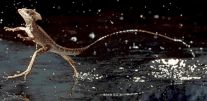 | This basilisk lizard is amazing. It has frilled flaps of skin around its neck. When threatened, it can flare these out to look larger and more fierce. This lizard also has the ability to fun on water. It has very specialized feet which can expand to have a large surface area. I got the best picture I could find to show you this amazing feat (no pun intended). | |
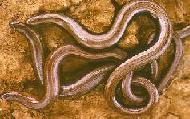 | The glass snakes, which are actually legless lizards, belong to the anguidae family. What's not to love about a lizard which looks like a snake? What is the difference between the two? You'll have to find out for yourself. | |
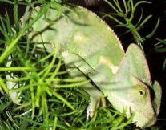 | My sister had a veiled chameleon for a pet once, and it really could change colors. Chameleons can turn from nearly white to various shades of green and brown. Don't expect a purple one anytime soon. They are slow moving, except for their eyes and tongues. Their eyes can move in separate directions, and their tongues may be longer than their bodies. They have two toes on each foot, and they can grasp with them and their tail. |
 This is an ancient order, but you will only find one living specimen, and that's the tuatara from New Zealand. The tuatara is a reptile with a beak head. In other words, there is an unusual arch in its head. It is believed that beak-headed reptiles were on the earth before the dinosaurs.
This is an ancient order, but you will only find one living specimen, and that's the tuatara from New Zealand. The tuatara is a reptile with a beak head. In other words, there is an unusual arch in its head. It is believed that beak-headed reptiles were on the earth before the dinosaurs.




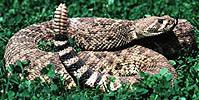
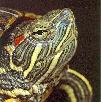 Turtles and tortoises seem to be a favorite. They are rather gentle reptiles and are familiar to most people. Actually, there are many turtle fans around the world and the internet. Lots of people want to help tortoises and turtles, which is a very good thing, especially when their environments are in danger, and many species are threatened. Perhaps there is a little bit of sympathy for the persistant, slow moving creatures.
Turtles and tortoises seem to be a favorite. They are rather gentle reptiles and are familiar to most people. Actually, there are many turtle fans around the world and the internet. Lots of people want to help tortoises and turtles, which is a very good thing, especially when their environments are in danger, and many species are threatened. Perhaps there is a little bit of sympathy for the persistant, slow moving creatures. 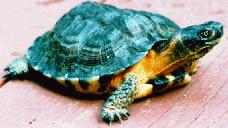 There are actually three groups of animals we call turtles. The only true turtles are the sea turtles. These are marine animals with flippers instead of feet. Some of these, like the leatherback turtle, may be longer than a person and weight nearly a ton. The great sea turtles are endangered. What about the other "turtles?" Most qualify as tortoises. Tortoises are land creatures with feet. They usually have high-domed shells and can live in the desert. A third group exists - the terrapin. These are freshwater turtles, and are common to the East-coast. Tortoises and terrapin don't seem to mind if you call them turtles though.
There are actually three groups of animals we call turtles. The only true turtles are the sea turtles. These are marine animals with flippers instead of feet. Some of these, like the leatherback turtle, may be longer than a person and weight nearly a ton. The great sea turtles are endangered. What about the other "turtles?" Most qualify as tortoises. Tortoises are land creatures with feet. They usually have high-domed shells and can live in the desert. A third group exists - the terrapin. These are freshwater turtles, and are common to the East-coast. Tortoises and terrapin don't seem to mind if you call them turtles though.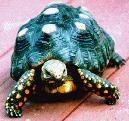 The most notable feature of a turtle is the shell. It is made of two halves, and the upper part is called the carapace. The lower part is called the plastron. These are bony growths, and a turtle can't leave its shell, no matter what you've seen in cartoons. The backbone of the animal is part of the carapace, and both carapace and plastron are firmly attached. Another interessting feature is the neck of the turtle. In some terrapin, the neck may be very long and can curve like a snake's neck. Other chelonian necks are not so dynamic.
The most notable feature of a turtle is the shell. It is made of two halves, and the upper part is called the carapace. The lower part is called the plastron. These are bony growths, and a turtle can't leave its shell, no matter what you've seen in cartoons. The backbone of the animal is part of the carapace, and both carapace and plastron are firmly attached. Another interessting feature is the neck of the turtle. In some terrapin, the neck may be very long and can curve like a snake's neck. Other chelonian necks are not so dynamic.
 The first creature which springs to mind when discussing crocodilians is the crocodile. For the most part, crocodiles are native to Africa, Austrailia and the eastern hemisphere. They are also found on the islands of the Pacific. One notable exception is the American Crocodile. This can be found at the southern tip of Florida and thorughout the tropics of the western hemisphere. Of all these crocodilians, the crocodile is by far the most aggressive. Even so, they don't really hunt humans, and if we avoid them, they tend to avoid us.
The first creature which springs to mind when discussing crocodilians is the crocodile. For the most part, crocodiles are native to Africa, Austrailia and the eastern hemisphere. They are also found on the islands of the Pacific. One notable exception is the American Crocodile. This can be found at the southern tip of Florida and thorughout the tropics of the western hemisphere. Of all these crocodilians, the crocodile is by far the most aggressive. Even so, they don't really hunt humans, and if we avoid them, they tend to avoid us. The alligator is primarily located in the western hemisphere, with one exception in China. The American alligator is primarily found along the coastal waters near the Gulf of Mexico. They need a moist, warm climate to survive. Once, alligators were nearly extinct, but a creative and controversial program has brought them back. Alligators were allowed to be used for leather and meat (a good cut is quite nice), but alligator breeders had to return 10% of their herd to the wild. Today, American alligators are doing quite well.
The alligator is primarily located in the western hemisphere, with one exception in China. The American alligator is primarily found along the coastal waters near the Gulf of Mexico. They need a moist, warm climate to survive. Once, alligators were nearly extinct, but a creative and controversial program has brought them back. Alligators were allowed to be used for leather and meat (a good cut is quite nice), but alligator breeders had to return 10% of their herd to the wild. Today, American alligators are doing quite well.
 Part of the alligator family is the caiman. These are found in the tropics around Central and South America. Caimans have bony scales in the skin of their abdomens, and they are the only crocodilians to have these. They can grow up to 5 meters (about 15 feet) in length.
Part of the alligator family is the caiman. These are found in the tropics around Central and South America. Caimans have bony scales in the skin of their abdomens, and they are the only crocodilians to have these. They can grow up to 5 meters (about 15 feet) in length.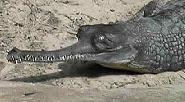 Possibly the strangest of the crocodilians is the gharial or gavial. Like all crocodilians, this creature eats meat, but the snout of the gavial is very narrow. Mostly it eats fish. At the Audubon Zoo in New Orleans, I first saw a gavial. I thought it was a mutant crocodile. It was incredibly strange. Normally, these creatures are native to India and Indonesia.
Possibly the strangest of the crocodilians is the gharial or gavial. Like all crocodilians, this creature eats meat, but the snout of the gavial is very narrow. Mostly it eats fish. At the Audubon Zoo in New Orleans, I first saw a gavial. I thought it was a mutant crocodile. It was incredibly strange. Normally, these creatures are native to India and Indonesia.
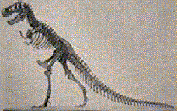 One final mention - dinosaurs. We are pretty sure dinosaurs are reptiles, but we haven't been able to classify them further. Generally, they are placed in their own sub-class, called Dinosauria. From there, the group is separated into the bird-like reptiles, or ornithischia and the lizard-like reptiles, or saurischia. Because we can't even determine whether these were warm or cold blooded, and aren't sure the number of chambers in the heart, any further relation to modern reptiles is up for debate. Current thought is that dinosaurs are more closely related to birds than any other living animal. If you're interested, I can find some links for you, but for now, I'll leave the dinosaurs to the archeologists.
One final mention - dinosaurs. We are pretty sure dinosaurs are reptiles, but we haven't been able to classify them further. Generally, they are placed in their own sub-class, called Dinosauria. From there, the group is separated into the bird-like reptiles, or ornithischia and the lizard-like reptiles, or saurischia. Because we can't even determine whether these were warm or cold blooded, and aren't sure the number of chambers in the heart, any further relation to modern reptiles is up for debate. Current thought is that dinosaurs are more closely related to birds than any other living animal. If you're interested, I can find some links for you, but for now, I'll leave the dinosaurs to the archeologists.